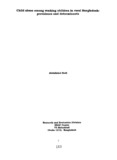Child abuse among working children in rural Bangladesh: prevalence and determinants

Date
1999Publisher
BRAC Research and Evaluation Division (RED)Author
Hadi, AbdullahelMetadata
Show full item recordCitation
Hadi, A. (1999). Child abuse among working children in rural Bangladesh: prevalence and determinants. Research Reports (1999): Social Studies, Vol – XXII, 163–176.Abstract
The paper aims to improve our understanding about the prevalence and determinants of child abuse in
rural Bangladesh. Data from the 1995 sample survey of 4,643 children aged 10-15 years in 150 villages
were used. Findings revealed that 21% of the children were in the labour force although the Bangladeshi
laws prohibited child labour. The prevalence of child abuse and exploitation was widespread in
Bangladeshi villages as 2.3% of all children were physically abused, 2% were financially exploited,
l.7% were forced to involve in inappropriate activities, and 3% were forced to work for long hours. The
prevalence of physical assault was much higher among younger children although the probability of
other types of abuse was higher among older children. Boys were more exposed than girls to be abused
of any kind. Poverty was also significantly associated with child abuse. Multivariate analysis suggested
that the out-of-school children and the children of illiterate, landless and unskilled labourers were more
likely to be abused than others when age and sex of children were controlled. The paper concludes that
raising public awareness against child abuse and promoting preventive measures should be adopted to
reduce child abuse in Bangladesh.
